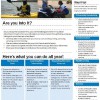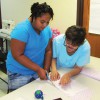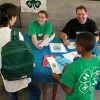 A project is a planned series of learning experiences of six hours or more within a particular area of youth interest (Florida 4-H definition). The purpose of a 4-H project is to promote mastery of subject matter and to foster life skill development. This 4-page fact sheet was written by Judith Levings, and published by the UF Department of 4-H Youth Development, August 2014.
A project is a planned series of learning experiences of six hours or more within a particular area of youth interest (Florida 4-H definition). The purpose of a 4-H project is to promote mastery of subject matter and to foster life skill development. This 4-page fact sheet was written by Judith Levings, and published by the UF Department of 4-H Youth Development, August 2014.
http://edis.ifas.ufl.edu/4h343
Tag: 4-H Youth Development
Protecting Youth and Volunteers by Planning Ahead, Reducing Risk
 The UF/IFAS Extension 4-H Youth Development Program is committed to the safety and well-being of its youth as well as the volunteers who help deliver 4-H programs under the supervision of 4-H faculty and staff. All things in life involve some sort of risk. This is especially true when working with youth, but there are many ways that volunteers can minimize this risk and lead safe 4-H activities. Proper planning and common sense certainly go a long way. Although not to be considered legal advice, here are some facts and issues to know and keep in mind while serving as a 4-H volunteer. This 3-page fact sheet was written by Keith G. Diem, and published by the UF Department of 4-H Youth Development, July 2014.
The UF/IFAS Extension 4-H Youth Development Program is committed to the safety and well-being of its youth as well as the volunteers who help deliver 4-H programs under the supervision of 4-H faculty and staff. All things in life involve some sort of risk. This is especially true when working with youth, but there are many ways that volunteers can minimize this risk and lead safe 4-H activities. Proper planning and common sense certainly go a long way. Although not to be considered legal advice, here are some facts and issues to know and keep in mind while serving as a 4-H volunteer. This 3-page fact sheet was written by Keith G. Diem, and published by the UF Department of 4-H Youth Development, July 2014.
http://edis.ifas.ufl.edu/4h342
Positive Discipline for Youth
 Working with youth, especially other people’s, can be a challenge. While some are better behaved than others, they all need acceptance and the opportunity to learn. Especially in groups of mixed ages, experience, or interests, the challenge of a youth leader is to see that disruptive youth do not prevent others from learning or having fun. Their very presence in the group, combined with your wise guidance, will help them learn what is socially acceptable and how to do what is right. This information sheet will help you to understand youth better and to provide some ideas on how to deal with the unruly kids with minimal disruption of the learning situation. This 5-page fact sheet was written by Heidi L. Radunovich, Keith G. Diem, and Georgene Bender, and published by the UF Department of 4-H Youth Development, July 2014.
Working with youth, especially other people’s, can be a challenge. While some are better behaved than others, they all need acceptance and the opportunity to learn. Especially in groups of mixed ages, experience, or interests, the challenge of a youth leader is to see that disruptive youth do not prevent others from learning or having fun. Their very presence in the group, combined with your wise guidance, will help them learn what is socially acceptable and how to do what is right. This information sheet will help you to understand youth better and to provide some ideas on how to deal with the unruly kids with minimal disruption of the learning situation. This 5-page fact sheet was written by Heidi L. Radunovich, Keith G. Diem, and Georgene Bender, and published by the UF Department of 4-H Youth Development, July 2014.
http://edis.ifas.ufl.edu/4h341
Making Learning Fun
 As a 4-H volunteer, one of your most important roles is helping youth learn. Especially because membership in 4-H is voluntary, learning in 4-H must be fun. Even if you’re not a teacher by profession, you can successfully guide youth to learn communication, leadership, citizenship, and other life skills, as well as subject matter through their 4-H projects and club participation. This 5-page fact sheet was written by Keith G. Diem and Judy Levings, and published by the UF Department of 4-H Youth Development, July 2014.
As a 4-H volunteer, one of your most important roles is helping youth learn. Especially because membership in 4-H is voluntary, learning in 4-H must be fun. Even if you’re not a teacher by profession, you can successfully guide youth to learn communication, leadership, citizenship, and other life skills, as well as subject matter through their 4-H projects and club participation. This 5-page fact sheet was written by Keith G. Diem and Judy Levings, and published by the UF Department of 4-H Youth Development, July 2014.
http://edis.ifas.ufl.edu/4h340
Planning a Successful Field Trip
 Field trips can be great experiences for youth to learn project content and life skills. Field trips also contribute to the experiential learning philosophy of 4-H. This document includes some suggestions to make a field trip fun, safe, and educational. This 3-page fact sheet was written by Keith G. Diem and Ben Knowles, and published by the UF Department of 4-H Youth Development, July 2014.
Field trips can be great experiences for youth to learn project content and life skills. Field trips also contribute to the experiential learning philosophy of 4-H. This document includes some suggestions to make a field trip fun, safe, and educational. This 3-page fact sheet was written by Keith G. Diem and Ben Knowles, and published by the UF Department of 4-H Youth Development, July 2014.
http://edis.ifas.ufl.edu/4h339
Adopting 4-H Club Bylaws
 Why does a 4-H club (for youth ages 8–18) need bylaws? For the same reason our country needs a constitution! By having fair and written rules, the rights of all members can be protected. The following is a suggested format for 4-H bylaws. The bylaws below may be adapted to meet local conditions. Be sure to send a copy of your club’s approved bylaws to your county 4-H office. Include in the bylaws the date when they were approved and most recently revised.This 3-page fact sheet was written by Keith G. Diem, Judy Levings, and Ben Knowles, and published by the UF Department of 4-H Youth Development, July 2014.
Why does a 4-H club (for youth ages 8–18) need bylaws? For the same reason our country needs a constitution! By having fair and written rules, the rights of all members can be protected. The following is a suggested format for 4-H bylaws. The bylaws below may be adapted to meet local conditions. Be sure to send a copy of your club’s approved bylaws to your county 4-H office. Include in the bylaws the date when they were approved and most recently revised.This 3-page fact sheet was written by Keith G. Diem, Judy Levings, and Ben Knowles, and published by the UF Department of 4-H Youth Development, July 2014.
http://edis.ifas.ufl.edu/4h338
The ABCs of 4-H: A Primer for 4-H Volunteers
 This information sheet is the introduction to the 4-H Volunteer Training Series (VTS). The series contains a wealth of information, from how to start a club, to planning field trips, to how to work with youth. This 5-page fact sheet was written by Keith G. Diem and Ben Knowles, and published by the UF Department of 4-H Youth Development, July 2014.
This information sheet is the introduction to the 4-H Volunteer Training Series (VTS). The series contains a wealth of information, from how to start a club, to planning field trips, to how to work with youth. This 5-page fact sheet was written by Keith G. Diem and Ben Knowles, and published by the UF Department of 4-H Youth Development, July 2014.
http://edis.ifas.ufl.edu/4h335
Selecting a Name for Your 4-H Club
 Each 4-H club is a unique group of individuals who work together toward common goals. A club name should reflect the purpose(s) of the club, often relating to the project(s) the club participates in, or the geographic area where members live or the club meets. One of the first ways to develop a sense of belonging and youth engagement is allowing all of the members to participate in selecting a name for the club. Information in this sheet may help you guide the members in making a wise name choice. This 2-page fact sheet was written by Keith G. Diem, Marilyn N. Norman, Joy C. Jordan, and Lindsey McConnell, and published by the UF Department of 4-H Youth Development, July 2014.
Each 4-H club is a unique group of individuals who work together toward common goals. A club name should reflect the purpose(s) of the club, often relating to the project(s) the club participates in, or the geographic area where members live or the club meets. One of the first ways to develop a sense of belonging and youth engagement is allowing all of the members to participate in selecting a name for the club. Information in this sheet may help you guide the members in making a wise name choice. This 2-page fact sheet was written by Keith G. Diem, Marilyn N. Norman, Joy C. Jordan, and Lindsey McConnell, and published by the UF Department of 4-H Youth Development, July 2014.
http://edis.ifas.ufl.edu/4h337
How to Start a Club (for Youth Ages 8–18)
 Being in a 4-H club provides important opportunities for youth to learn subject matter and life skills while working with a caring adult and other youth. Once youth are 4-H members, they become eligible for a variety of the benefits of belonging to 4-H, including awards, trips, and special events. Of course, it’s meant to be fun for the kids and the leaders too! Starting a 4-H club isn’t difficult, and you are encouraged to seek help from parents or other volunteers. Local Extension/4-H staff can help you get started. This 4-page fact sheet was written by Keith G. Diem, Joy Jordan, Bryan Terry, Dale Pracht, Judy Butterfield, Adam Cletzer, Lindsey McConnell, and Ben Knowles, and published by the UF Department of 4-H Youth Development, July 2014.
Being in a 4-H club provides important opportunities for youth to learn subject matter and life skills while working with a caring adult and other youth. Once youth are 4-H members, they become eligible for a variety of the benefits of belonging to 4-H, including awards, trips, and special events. Of course, it’s meant to be fun for the kids and the leaders too! Starting a 4-H club isn’t difficult, and you are encouraged to seek help from parents or other volunteers. Local Extension/4-H staff can help you get started. This 4-page fact sheet was written by Keith G. Diem, Joy Jordan, Bryan Terry, Dale Pracht, Judy Butterfield, Adam Cletzer, Lindsey McConnell, and Ben Knowles, and published by the UF Department of 4-H Youth Development, July 2014.
http://edis.ifas.ufl.edu/4h336
4-H School Enrichment: A Guide for 4-H Faculty and Staff (4H324)
 A partnership with the schools extends the 4‑H program to more youth through a unique delivery mode. Since School Enrichment may be a new experience for some Extension agents, this 8-page guide presents some strategies for developing a partnership with the schools and for programming. Written by Tracy A. Tesdall and published by the 4-H Youth Development Program, September 2012.
A partnership with the schools extends the 4‑H program to more youth through a unique delivery mode. Since School Enrichment may be a new experience for some Extension agents, this 8-page guide presents some strategies for developing a partnership with the schools and for programming. Written by Tracy A. Tesdall and published by the 4-H Youth Development Program, September 2012.
http://edis.ifas.ufl.edu/4h324
Starting and Maintaining 4-H Clubs (4HGCL00/4H281)
 This 16-page guide, intended for 4-H staff and volunteers, provides an overview to the types of clubs, the criteria and forms for chartering a new club, and for maintaining club status annually. It also outlines the fiscal responsibilities of club management and the standards for recognition. Written by J. Jordan, B. Terry, D. Pracht, J. Butterfield, and A. Cletzer, and published by the UF Department of 4-H Youth Development, March 2012.
This 16-page guide, intended for 4-H staff and volunteers, provides an overview to the types of clubs, the criteria and forms for chartering a new club, and for maintaining club status annually. It also outlines the fiscal responsibilities of club management and the standards for recognition. Written by J. Jordan, B. Terry, D. Pracht, J. Butterfield, and A. Cletzer, and published by the UF Department of 4-H Youth Development, March 2012.
http://edis.ifas.ufl.edu/4h281
Selecting Pigs for Youth Swine Shows (4HSWG04/4H210)
 Are you interested in participating in a swine show? This 8-page fact sheet will help youth exhibitors determine how and where to purchase a project pig and provide information on what the student should look for when purchasing the pig in order to do well. Published by the UF Department of 4-H Youth Development, April 2012.
Are you interested in participating in a swine show? This 8-page fact sheet will help youth exhibitors determine how and where to purchase a project pig and provide information on what the student should look for when purchasing the pig in order to do well. Published by the UF Department of 4-H Youth Development, April 2012.
http://edis.ifas.ufl.edu/4h210
Florida 4-H Treasurer’s Manual and Record Book (4HGCR02/4H012)
 So you’ve been elected treasurer of your 4-H club! This 36-page record book will help guide you in your duties and responsibilities, and will be the official financial record of your club. Written by Joy Jordan and published by the UF Department of 4-H Youth Development, March 2012.
So you’ve been elected treasurer of your 4-H club! This 36-page record book will help guide you in your duties and responsibilities, and will be the official financial record of your club. Written by Joy Jordan and published by the UF Department of 4-H Youth Development, March 2012.
http://edis.ifas.ufl.edu/4h012
Investigating the Fungus Among Us: A 4-H Educational Curriculum on Mold (4HHLL70/4H311)
This unit investigates both the benefits and the dangers of mold or mold-based products. By completing the activities in each of the five lessons, youth (grades 5-8) will examine the positive and negative attributes of mold, the conditions that promote mold growth, and how growth can cause illness. They will also learn methods used to deal with mold growth in the home. This 58-page curriculum was written by Jessica Kochert and Joy Jordan, and published by the UF Department of 4-H Youth Development, March 2011.
http://edis.ifas.ufl.edu/4h311
Rabbits, Rabbits, Rabbits: Online Record Books
These online record books familiarize youth with the importance of record keeping as an integral part of project management. By tracking inventory, financial records associated with their project, rabbit health and grooming details, and related information, youth will be well prepared to relate their experiences in a written narrative as part of their project completion activities. Written by Joy Jordan, Loretta Rodriguez, Jessica Kochert, Bill Heltemes, Chris Decubellis, and Renée Gore, and published by the UF Department of 4-H Youth Development, March 2011.
- Pet Rabbit Record Book (4HRAR11/4H319)
http://edis.ifas.ufl.edu/4h319 - Show Rabbit Record Book (4HRAR12/4H320)
http://edis.ifas.ufl.edu/4h320 - Market Rabbit Record Book (4HRAR13/4H321)
http://edis.ifas.ufl.edu/4h321
Florida 4-H Cloverbuds: A Programming Guide for Staff and Volunteers (4HGCL23/4H317)
4-H Cloverbuds, age 5-7, have unique learning characteristics and developmental needs that are different from older members. As a result, the 4-H Cloverbuds program is designed with specific educational objectives and program policies focused on the 5–7 year-old child. This 36-page fact sheet was written by Joy C. Jordan, Kate Fogarty, Tracy Tesdall, and Renée Gore, and published by the UF Department of 4-H Youth Development, March 2011.
http://edis.ifas.ufl.edu/4h317
4-H Horse and Pony Lease (4HHSF01/4H318)
In the Florida 4-H Horse Lease Program, the same animal may be leased by up to three 4-H members and all Lessees must conform to the requirements of the Florida 4-H Equine Program. This revised 7-page publication contains the forms that might be needed for one 4-H’er to lease a horse: a page of instructions, a page of advice, the 3-page lease form, and 2 copies of the addendum (if up to two others are sharing Horse). Written by E.L. Johnson and Wendy DeVito, and published by the UF Department of 4-H Youth Development, March 2011.
http://edis.ifas.ufl.edu/4h318
Forensic Entomology (4HENL41/4H310)
Forensics is a hot topic, with many movies and popular television shows (such as “CSI”) introducing youth to the tools, processes, and critical thinking skills needed to solve various crimes. Within this world, insects have a growing presence. The field of forensic entomology focuses on the information that insects provide investigators about the time, location, and criminal negligence within a wide variety of criminal cases. This curriculum is a tool for teaching youth grades 6–8 about the contributions that insects make to the world of forensics. This three-week series of lesson activities is designed for use in after-school programs, summer day camps, and 4-H clubs. However, this package also includes the Next Generation Sunshine State Standards for teachers within formal classroom settings. It was written by Erika Andersen and Russell Mizell with Jessica Kochert and Joy Jordan, and published by the UF Department of 4-H Youth Development, January 2011.
http://edis.ifas.ufl.edu/4h310
A Guide to the Florida 4-H Council (4HGCM12/4H315)
A 4-H Council at county, district, and state levels is one of the tools the 4-H Program uses to provide educational experiences for youth. A Council is an elected representative group of 4-H members who meet, discuss, plan, and assist in carrying out 4-H programs and activities in the interest of the total membership. The Council provides links between local clubs or groups and County 4-H Programs, County Programs and District 4-H Programs, and District Programs and State 4-H Programs.
This revised 20-page guide, written by J.A. Rutledge, Joy C. Jordan, Wendi Armstrong, and Tracy Tesdall, includes the consitution, bylaws, annual calendar, and 4-H pledge. Published by the UF Department of 4-H Youth Development, January 2011.
http://edis.ifas.ufl.edu/4h315
4-H SAVE: Steps in Achieving Viable Energy project
The 4-H SAVE project is a new energy education curriculum for youth, ages 11 to 13, taking them on a journey through the exciting world of energy. Three different modules are available within this curriculum: